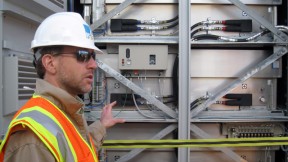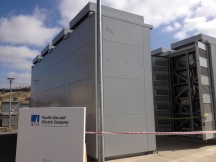
You probably wouldn’t notice it if you drove right past it — but this week PG&E unveiled California’s largest battery, now storing electrons in San Jose. The project is a pilot for energy storage technology, as electric utilities look for ways to balance increasing amounts of solar and wind energy on the grid.
The 4-megawatt sodium-sulfur array can power about 2,400 homes for up to seven hours. That takes a mighty big battery. “If you pulled a semi-truck up next to it, it would be about the same length and a little bit taller,” says Jon Eric Thalman of PG&E.
Storing electricity is not something utilities have traditionally done. “On the grid, we generate the amount of power that is needed, minute-by-minute,” Thalman says. “We don’t store it and have it at the ready.”
But the electric grid is rapidly changing in California. When the sun is shining and the wind is blowing, solar and wind farms produce electricity much like traditional power plants do. But if clouds pass over a solar project, “the change in power can be 80 percent of its output, easily,” says Thalman. “Something has to make up that drop and it happens in seconds.”

That’s where PG&E’s battery project comes in. While this project is small, PG&E says it’s a pilot for energy storage projects down the road. “It is one of the main ways to think about storing energy because it’s so flexible, but there are challenges as have to solve,” says Venkat Srinivasan, of the Joint Center for Energy Storage Research at Lawrence Berkeley National Lab.
